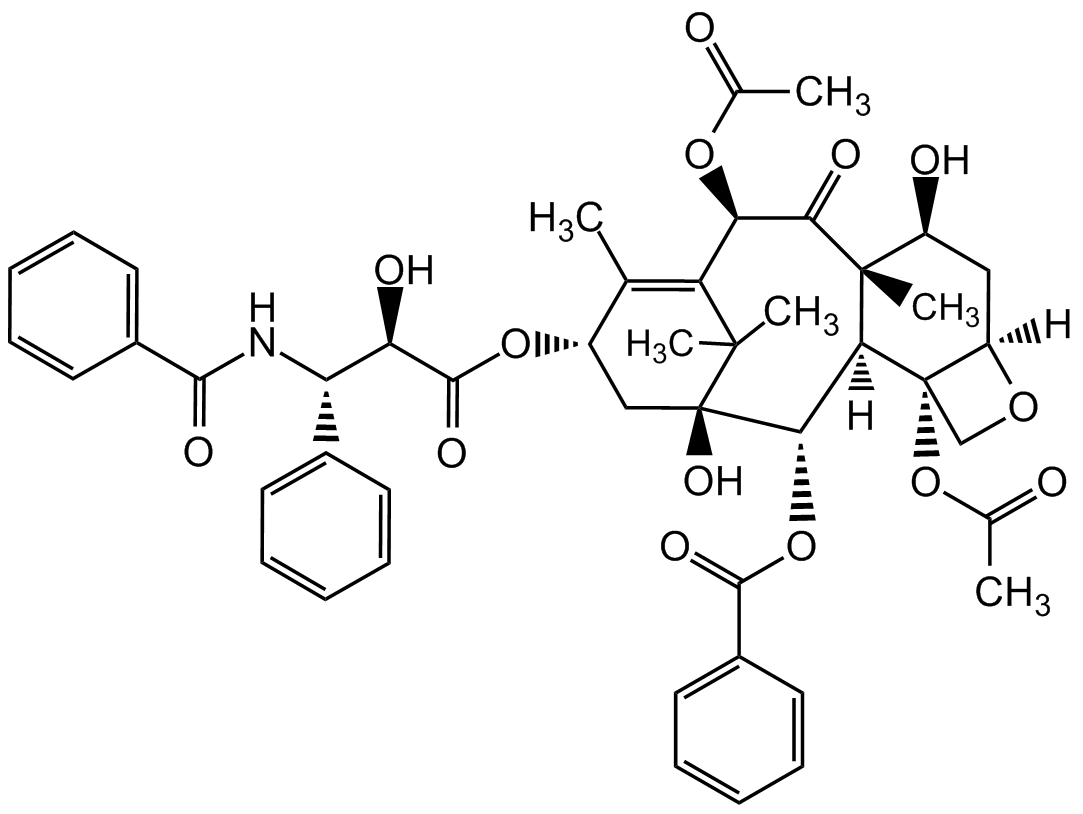
Chemical Structure
Paclitaxel
AG-CN2-0045
CAS Number33069-62-4
Product group Chemicals
Estimated Purity>99%
Molecular Weight853.9
Overview
- SupplierAdipoGen Life Sciences
- Product NamePaclitaxel
- Delivery Days Customer10
- CAS Number33069-62-4
- CertificationResearch Use Only
- Estimated Purity>99%
- Hazard InformationDanger
- Molecular FormulaC47H51NO14
- Molecular Weight853.9
- Scientific DescriptionAnticancer compound [1, 11, 14]. Chemotherapeutic used in patients with cancer and advanced forms of Kaposis sarcoma [11, 12]. Microtubule assembly stabilizer. Reversibly binds to polymerized tubulin [2, 3, 6, 13, 14]. Anti-mitotic. Mitotic spindle assembly, chromosome segregation and cell division inhibitor. Induces cell cycle arrest at the G2/M phase [4, 5, 10, 13]. Apoptosis inducer through aberrant activation of cyclin-dependent kinases (CKDs) and the c-Jun N-terminal kinase/stress activated protein kinase (JNK/SAPK) [7-9, 10]. Immunosuppressor. Immunostimulant [15]. Antiproliferative agent for the prevention of restenosis [16]. TRAIL sensitizer [17] - Chemical. CAS: 33069-62-4. Formula: C47H51NO14. MW: 853.9. Isolated from the bark of the pacific yew tree (Taxus brevifolia). Anticancer compound. Chemotherapeutic used in patients with cancer and advanced forms of Kaposis sarcoma. Microtubule assembly stabilizer. Reversibly binds to polymerized tubulin. Anti-mitotic. Mitotic spindle assembly, chromosome segregation and cell division inhibitor. Induces cell cycle arrest at the G2/M phase. Apoptosis inducer through aberrant activation of cyclin-dependent kinases (CKDs) and the c-Jun N-terminal kinase/stress activated protein kinase (JNK/SAPK). Immunosuppressor. Immunostimulant. Antiproliferative agent for the prevention of restenosis. TRAIL sensitizer
- SMILES[H][C@@]12C[C@H](O)[C@@]3(C)C(=O)[C@H](OC(C)=O)C4=C(C)[C@H](C[C@@](O)([C@@H](OC(=O)C5=CC=CC=C5)[C@]3([H])[C@@]1(CO2)OC(C)=O)C4(C)C)OC(=O)[C@H](O)[C@@H](NC(=O)C1=CC=CC=C1)C1=CC=CC=C1
- Storage Instruction-20°C,2°C to 8°C
- UNSPSC12352200




![Paclitaxel [33069-62-4]](https://www.targetmol.com/group3/M00/35/EF/CgoaEWayMfiEKscWAAAAAFuYVvg920.png)
